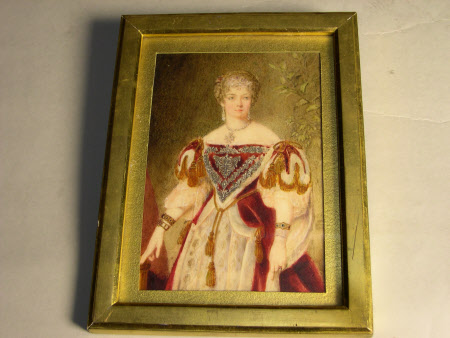Lady Emma Sophia Edgcumbe, Countess Brownlow (1791-1872)
British (English) School
Category
Art / Miniatures
Date
1830
Materials
Watercolour on vellum
Measurements
190 x 140 mm
Order this imageCollection
Belton House, Lincolnshire
NT 436002
Summary
Portrait miniature, watercolour painting on vellum, Lady Emma Sophia Edgcumbe, Countess Brownlow (1791-1872), British (English) School, 1830. Three-quarter-length portrait of a young woman, turned to the left, gazing to the right, wearing a dress trimmed with red velvet and gold tassels pendant earring, a necklace with gold cross, engagement and wedding rings on her fingers and four wrist bangles. Blue eyes, fair hair dressed with pearls. Buff background with a green plant. Inscribed on back, Emma Countess Brownlow - painted in Coronation Robes when she was one of the Queen Adelaide's Ladies in Waiting.' Lady Emma Sophia Edgcumbe, Countess Brownlow (1791-1872), eldest daughter of Richard Edgcumbe, 2nd Earl of Mount Edgcumbe (1764-1839) and Lady Sophia Hobart (1768-1806), third daughter of John Hobart, 2nd Earl of Buckinghamshire (1723-1793); married in 1828, as his third wife, John Cust, 1st Earl Brownlow (1779-1853), but bore him no children.She has spent her youth trailing around Europe with her uncle Lord Castlereagh, on his official visits as Foreigh Secretary. She held the office of Lady of the Bedchamber to Queen Adelaide between 1830 and 1849 and formed a close relationship with her. The widowed Adelaide came to stay at Belton and a bedchamber was redecorated for the occasion and duly renamed the Queen's Bedroom. Lady Emma wrote Reminiscences of a Septuagenarian which was published in 1868.
Marks and inscriptions
Emma Countess Brownlow - painted in Coronation Robes when she was one of the Queen Adelaide's Ladies in Waiting (inscribed on reverse)
Makers and roles
British (English) School, artist
